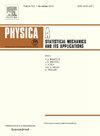Experimental study of pedestrian dynamics and crowd risk on ramps
IF 2.8
3区 物理与天体物理
Q2 PHYSICS, MULTIDISCIPLINARY
Physica A: Statistical Mechanics and its Applications
Pub Date : 2025-02-01
DOI:10.1016/j.physa.2024.130345
引用次数: 0
Abstract
This study investigates pedestrian dynamics and crowd risk on ramps, a topic not fully explored in previous research. Our experimental setup covers a boarder range of densities for both walking and running scenarios. Our main findings include: (1) Once pedestrian density exceeds 1.70ped/m2, flow rates continue to increase and remain consistently higher during ascending the ramp compared to descending, a trend not observed on level ground. This phenomenon can be explained by step behavior mechanisms, driven by the transition from two to three lanes, which help maintain consistent headway and step lengths. (2) The addition of walking lanes increases velocity curl (i.e., local spinning motion) on the ascending segment, especially in running scenarios. When combined with the high-density levels typically seen in ascending movement, these effects amplify crowd danger. Statistical analyses confirm crowd risks are more strongly correlate with movement directions (descending vs. ascending) than with movement speeds (walking vs. running).
求助全文
约1分钟内获得全文
求助全文
来源期刊
CiteScore
7.20
自引率
9.10%
发文量
852
审稿时长
6.6 months
期刊介绍:
Physica A: Statistical Mechanics and its Applications
Recognized by the European Physical Society
Physica A publishes research in the field of statistical mechanics and its applications.
Statistical mechanics sets out to explain the behaviour of macroscopic systems by studying the statistical properties of their microscopic constituents.
Applications of the techniques of statistical mechanics are widespread, and include: applications to physical systems such as solids, liquids and gases; applications to chemical and biological systems (colloids, interfaces, complex fluids, polymers and biopolymers, cell physics); and other interdisciplinary applications to for instance biological, economical and sociological systems.

 求助内容:
求助内容: 应助结果提醒方式:
应助结果提醒方式:


